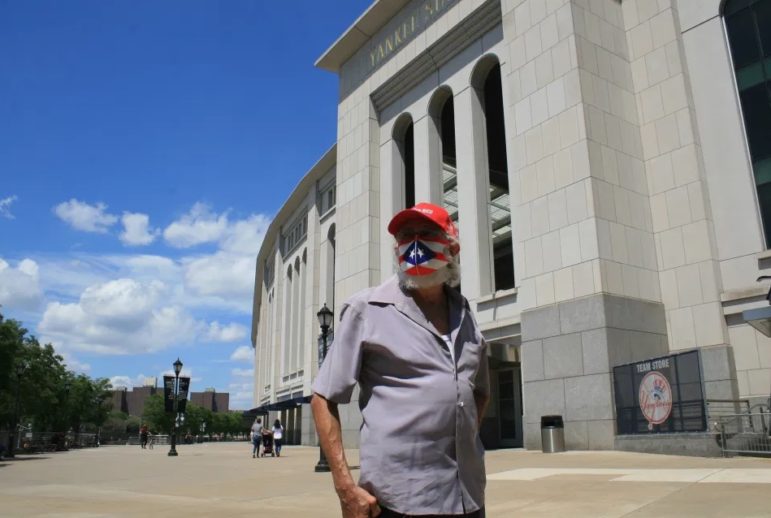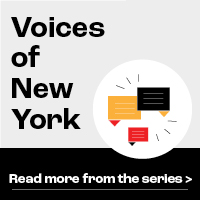
El Diario
Jorge Pérez, who has been a Yankees fan for 50 years, laments The Bronx’s economic debacle. ‘It is dead around here.’Read the original story in Spanish at El Diario
Translated and condensed by Carlos Rodríguez Martorell
Jorge Pérez, from Puerto Rico, has lived near Yankee Stadium for 50 years, and this is the first summer he won’t experience the excitement of supporting his favorite team from the grandstand. The impact of the coronavirus pandemic on the 2020 Major League Baseball season is not only forcing fans like him to watch from home, but devastating hundreds of families who make a living selling to the crowds that usually gather around the colossal Bronx stadium.
“It is dead around here,” says Pérez. “At the end of the day, baseball is what moves the economy in this area of New York. It is a multi-billion dollar business, so just think about the losses. They are not selling tickets because the games are being played without an audience. On the other hand, fans are the source of income of most of the merchants and workers in these neighborhoods.”
There will be no crowds of fans this year outside the stadium. The season normally begins in April, but COVID-19 almost forced the League to suspend it altogether.
This “new reality” has delivered a deadly blow to the livelihood of many Latino families who work as street vendors and depend on the informal economy. This is the case of Dominican-born Luzmila Feliz, 45, who used to make a living selling bottled water near the stadium.
“When there was an evening game, particularly in the summer, thousands of people began queuing early outside the stadium because they did not have tickets,” says the merchant. “The whole bustle of people on queues waiting to get in, and all the tourists who just came to see the stadium and take pictures. There were a lot of people coming and going starting in April. This year, all of that is gone.”
While the city’s rules prohibit vendors from selling goods on the street near the home of the Bronx Bombers, in practice, hundreds of people dodge the regulations by merging with the crowd.
“Ultimately, we are not doing anything wrong,” says Feliz. “It is a service. Obviously, many fellow merchants have been fined, but that is part of the risk. Tomorrow…there is supposed to be a game without spectators, but many people gather outside. We are going to try to sell something.”
While street vendors miss the crowds, brick and mortar businesses along 161th Street and near the stadium’s four local subway entrances, which for decades have been vibrant corners of the city, now describe their situation as catastrophic.
Since being allowed to reopen during the city’s Phase 3, a merchant in one of the sports souvenirs shops nearby told El Diario there have been days where they’ve earned less than $100.
“We only have one person working here now. There are no tourists. There are no fans. And the rent is around $10,000. You do the math,” says the merchant, who is Latino. “I think that, unfortunately, all of this will be shut down before Christmas.”
Around mid-April, at the peak of the pandemic in the city, Mayor Bill de Blasio addressed the return of fans to Yankee Stadium, stating that many months could pass before it went back to “normal.”
“I think it’s going to be a while. I think that’s one of the things later in the trajectory,” the mayor said at the time.
Puerto Rican-born Paul Vargas has lived near the stadium since 1983, and says he cannot remember seeing so much economic devastation in the Bronx neighborhood.
“Many people here depend on what goes on before, during and after a game. I have many friends and acquaintances who are having a hard time. Here, the coronavirus attacked us from all fronts, and it looks like the recovery will be very slow. There is no life left this year,” says Vargas.
Israel Rodríguez, also Puerto Rican, has experienced the baseball season up-close for 52 years, including the hustle and bustle that takes place around the stadium. He explained that “many merchants have gone under already.”
“Who are they going to sell to? There isn’t the faintest expectation that more people are coming,” says Rodríguez. “This part of The Bronx – Jerome Avenue, Highbridge, Concourse Village and 161th Street – is a Latino working-class area, and it has been hit the hardest by this crisis, including around the stadium.”
Read more on the pandemic’s impact on Bronx businesses here.










2 thoughts on “Latino Families Near Yankee Stadium Face Economic Devastation”
I guess you can console yourself by knowing that you contributed to the Yankees’ wealth.
Hello, I hope all is well. My name is Andrew Rosario and I am a junior at Lehman College. I am currently attending a Journalism class and my professor has insisted that we reach out to publications who focus on current effects. I have come across and have grown interested in this article and was wondering if it was okay to ask a couple of questions that would help with my assignment for the class.
Specifically,
1. How do you ensure that your work is accurate and factual?
2. What is your publications mission for the people?
3. Has the publication made any impact, specifically for those of low and middle classes?
4. What do you consider to be credible sources?
5. Has your work made any impact to government officials?
I hope that you can take the time to answer these questions. I would truly appreciate it.
Thank you so much for your time and patience. Have a blessed one.